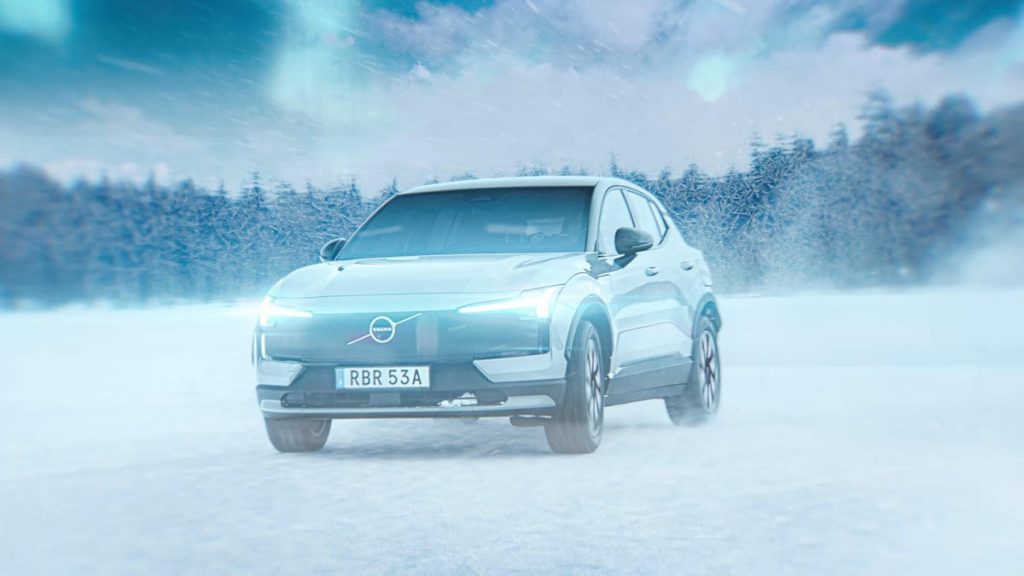
I felt the automotive tires lose grip on the floor of the frozen lake and my automotive begin to spin out. I knew I might pushed it too far. Regardless of the recommendation I might been given, I entered the nook too quick and hit the brakes too late. I believed I had the driving expertise to carry the slide I used to be now in, however physics had different concepts. As a substitute of my deliberate easy drift throughout the ice, the automotive went right into a full 360-degree spin that despatched me off the monitor and right into a deep snow ditch.
Fortunately, the powdery snow that cushioned my crash meant I used to be unharmed — as was the Volvo EX30 Cross Nation I used to be testing. My location was a frozen lake about two hours exterior of the northern Swedish metropolis of Lulea. Volvo had invited me to place its new automobile to the take a look at in a number of the most demanding climate circumstances for any automobile.
It sounded thrilling and, in fact, nice enjoyable, but it surely gave me a chance to show to myself one thing elementary about electrical vehicles: The miles of frozen roads and icebound lakes I drove throughout confirmed that EVs aren’t simply usable in winter — they’ll thrive in harsh, chilly circumstances.
The times of EVs being a uncommon sight on our roads are lengthy gone. It is estimated that in 2024, greater than 1.2 million EVs have been bought within the US, a big improve from the 326,000 estimated to have been bought in 2019. Electrical vehicles have confirmed that they are not only a novelty pushed by Ed Begley Jr. — they’re totally fledged autos in their very own proper, providing pleasing, dependable, zero-emission driving for thousands and thousands of individuals in all circumstances the world over.
However misconceptions stay round EV driving, particularly in colder climate. A easy Google search on the subject will carry up a wide range of US information stories on “stranded EV drivers within the snow,” articles about EV drivers “wrestling with the chilly,” varied YouTube movies, and Reddit and Quora threads — usually that includes inaccurate or deceptive data — all primarily telling potential EV homeowners that in the event that they wish to drive in colder months, they’re higher off shopping for a gas-powered automotive.
Once I advised a buddy of mine I used to be going to the Arctic to drive EVs, their response was: “Do they even work within the chilly?”
The reply, basically, is sure. And whereas misconceptions round EVs aren’t more likely to ever go away fully, these unsure about an EV’s capability to deal with colder temperatures want solely look towards Norway. Regardless of the nation’s excessive winter temperatures, electrical autos accounted for nearly 90% of all new vehicles bought in Norway in 2024.
“Electrical autos are getting higher on a regular basis,” Maria Cecilia Pinto de Moura, a scientist within the Clear Transportation program on the Union of Involved Scientists, tells me, “with new battery know-how bringing down the price of a brand new EV and growing their vary.”
The fact is that all vehicles battle extra within the winter, whether or not they’re powered by electrical energy or fuel. Colder temperatures make any automobile much less environment friendly, whereas icy roads cut back friction, growing the potential of accidents. It is particularly problematic for folks dwelling in rural areas, who sometimes depend on their autos for longer routes, usually throughout harder roads than city customers would face.
And whereas EV drivers can expertise extra challenges than these driving gas-powered autos — most notably, lesser availability of public charging stations — driving EVs in powerful winter circumstances is completely manageable.
To learn how EVs can thrive within the chilly, I journeyed to Volvo’s residence nation of Sweden to get behind the wheel of its newest EVs and see how they deal with snowbound roads and freezing circumstances and learn how EV homeowners can assist their vehicles go additional within the chilly.
The Volvo EX30 Cross Nation exhibits off on a frozen lake.
Electrical versus gas-powered autos
Regardless of the distinction in energy supply, in some ways EVs do not differ that a lot from inside combustion engine vehicles when pushed on the highway. In some respects, EVs can truly be safer. The battery packs sometimes make EVs a lot heavier, which might improve braking time however also can lead to higher traction in slippery circumstances. Most electrical autos from all manufacturers — together with Ford, Hyundai, Kia, Tesla, Volvo, VW and an growing variety of others — have their batteries positioned low down within the chassis. This leads to a extra even weight distribution and a decrease middle of gravity, giving a planted stance on the highway and offering improved grip on all wheels.
Then there are the electrical motors powering the vehicles, which give instantaneous torque to the wheels, permitting for smoother acceleration with out lack of traction. Many EVs even have twin motors, powering the entrance and rear wheels independently, once more growing general traction in poor circumstances.
Nonetheless, I did really feel barely nervous the primary time I took the wheel of Volvo’s EX90 in northern Sweden and headed out on a two-hour cross-country drive. The winding roads have been flanked by large snow drifts, highway junction markings have been invisible beneath the deeply packed snow and at one notably odd-feeling second after I glanced on the sat-nav, I noticed I used to be driving straight throughout the center of an unlimited, frozen lake, which evidently simply turns into a highway throughout winter.
However I needn’t have nervous: Driving the automotive in these circumstances felt not simply secure, it felt… common. Virtually boring.
The grip from the moment torque and twin motor drive was noticeable each time I pulled out at a junction, whereas the planted nature of the automotive from its whopping 2,800kg (6,200 pound) weight meant I by no means felt it was dropping grip within the corners. It made the journey really feel as pleasing as another and I did not even really feel like I wanted to make many specific allowances for the snow, past preserving my velocity in examine.
On one event, my co-driver needed to brake onerous after we got here up on some reindeer mendacity down within the highway. He braked onerous, the automotive slowed and the reindeer merely bought up and wandered off. No drama, no skidding off the highway, no hard-to-explain reindeer-shaped dents within the automotive.
Issues modified after I arrived on the frozen lake the place Volvo had carved a racetrack into the thick ice to permit us to check the vehicles off highway. Right here, the aim wasn’t a lot to really feel how regular it’s to drive EVs in winter however to push the bounds of the autos and, fairly frankly, to have some enjoyable attempting to make them go sideways. And it was enjoyable; I’ve pushed efficiency vehicles on common tracks earlier than when my intention always has been to attempt to keep away from going right into a slide and spinning into the boundaries.
However out on the ice, sliding turned my aim. I cherished the texture of powering right into a nook, giving the steering wheel a fast flick and feeling the automotive’s rear wheels lose grip, placing me right into a slide and attempting to carry it in an clever drift across the nook, excitedly feeling as if I am channeling the spirit of the late, nice Ken Block. Generally I managed it — regardless of the automotive’s varied traction management programs combating to regain management — whereas different instances I misplaced management totally and plowed harmlessly into the snow in conjunction with the monitor.
It is the form of “managed recklessness” I’ve by no means accomplished in a automotive earlier than, as a result of it could have been unlawful, harmful or each. However on this closed monitor in secure circumstances, all bets have been off.
Even so, I discovered it outstanding how a lot management I did nonetheless have on the ice, particularly after I wasn’t driving like I had a dying want. At regular speeds, the automotive would go across the monitor with as a lot sideways razzle-dazzle as you’d need when driving your grandma to a bake sale. It did not spin its wheels when accelerating from a cease and the brakes labored precisely as I might anticipate them to.
In northern Sweden, winter will be chilly and comfortable on the identical time.
Ready for winter
It is vital to notice that the vehicles we have been driving — the Volvo EX90 and new EX30 Cross Nation — have been fitted with studded winter tires, which do make all of the distinction in these circumstances. Having pushed snowbound roads with out winter tires, I do know simply how terrifying it may be.
In 2019 I took the VW Golf R (a gas-powered automotive) on a highway journey from Geneva, Switzerland, throughout continental Europe and again residence to London. It was a mammoth journey and, whereas a lot of the route encompassed blissful miles of curving tarmac, I made a giant error in taking a high-altitude mountain go.
Whereas the mountain highway data boards confirmed that many routes have been closed, the Julier Move that I wanted was marked as open. So I pointed my automotive firmly upward and loved the dynamic curves of the highway and the more and more spectacular views as I climbed larger up the go. However as my altitude elevated, so too did the quantity of snow on and to the facet of the highway.
Certain, I slowed my velocity proper all the way down to accommodate the shortage of traction however I felt snug that the four-wheel drive of the Golf can be sufficient to see me up and over. I shortly realized how unsuitable I used to be as I gently examined the brakes and located them to be successfully ineffective — as was the steering. Panic started to take over as I noticed I had little management over the automotive and each nook I got here to turned a much bigger problem to get the automotive round.
At this level I made the choice to take off my seatbelt and hold one hand prepared to tug on the door deal with. So satisfied was I that the subsequent bend would ship the automotive sliding off the sting of the mountain, I used to be getting ready to bail out, letting the automotive (and my baggage) go over the facet, whereas I hopefully stood an opportunity of leaping to security.
These skeletal rigs in Volvo’s testing facility enable the entire automotive programs — from the batteries to the AC unit and infotainment array — to be arrange as in an actual automobile and examined collectively.
When that bend arrived, I truly managed to slip the automotive right into a conveniently positioned snow drift, stopping the automotive with little greater than a delicate bump. I used to be then in a position to flip round and head again down, discovering a close-by lodge to relaxation for the night and have a beer to settle my nerves.
This was an enormous studying expertise for me in winter driving with any automotive. First, I hadn’t checked what tires have been on the automotive and, because it seems, they weren’t appropriate for snowy circumstances. Second, I wrongly assumed that the mountain highway being marked as “open” meant it was truly secure for any automotive to go. It actually solely implies that it hasn’t been closed with boundaries so you continue to must train much more sense in driving it in off-road succesful autos with appropriate winter tires, studs or snow chains fitted.
It was a lesson I remembered solely too clearly when I drove the Lotus Eletre EV a largely blissful 4,000 miles to and from Barcelona final yr. After a cease in a reasonably rural charging station in northern Spain, I took a route that wound its method first by way of forests earlier than beginning to climb larger into the hills. Whereas this highway wasn’t thought-about a “mountain go” just like the one I might beforehand pushed, the fast buildup of recent snow on the highway began to ring all-too-familiar alarm bells with me and I made the choice to show again and plan another route.
The issue I confronted this time, nevertheless, was that I used to be in an EV, not a gas-powered automotive and I might calculated the space to my subsequent charging level primarily based on taking this route. Doubling again and discovering a unique route meant including a number of additional distance to my journey, leaving me out of the blue affected by the dreaded curse of vary anxiousness.
EV vary within the chilly
An EV’s vary is without doubt one of the greatest components folks think about when selecting their automobile, and it is comprehensible that somebody may be involved about their battery life dropping when the temperatures are low. In any case, you do not wish to be caught out in the midst of nowhere as a result of your automotive was out of the blue unable to drive the identical route you probably did in the summertime. A 2024 survey by the Canadian Vehicle Affiliation indicated that greater than two-thirds of Canadians discover the drop in vary within the winter to be the most important concern for EVs.
It is true that batteries do not carry out as effectively in decrease temperatures. The chilly causes the electrolyte fluid present in lithium-ion batteries (those most frequently utilized in EVs) to thicken, which slows down the speed at which the lithium ions can transfer between the anode and the cathode.
These testing chambers for EV batteries will be chilled to minus 30 levels Celsius or warmed as much as 70 levels Celsius (minus 20 to 158 levels Fahrenheit), with various levels of humidity.
Jargon apart, what that merely means is that, when chilly, batteries aren’t in a position to maintain as a lot cost as they in any other case would. Some research have proven that EVs can lose as much as 25% of their most vary in freezing circumstances. It is not simply vary that is impacted; an inefficient battery additionally will not cost as shortly, so it’s possible you’ll must spend longer at outside public charging factors.
However earlier than you cancel your Polestar 3 order, let’s add some context on the facet of EVs. Whereas it’s true that EVs can lose as much as 25% of their vary within the chilly, some research present that gas-powered vehicles can equally be as much as 20% much less gasoline environment friendly in the identical circumstances than they might be when it is heat. What electrical motors and the extra acquainted inside combustion engines have in widespread is that they each carry out worst when ranging from chilly; batteries are inefficient when chilly and so are the inner workings — and fluids — of an inside combustion engine. As soon as they get warmed up, general effectivity improves.
That is sometimes a better process for a combustion engine automobile, because the engine itself generates a number of warmth whereas in use, offering an successfully free warmth supply to flow into into the cabin, preserving the driving force heat on chilly days. An EV’s electrical motors produce little warmth naturally, so the conditioning of the batteries and the heating of the cabin must be accomplished artificially, utilizing electrical heaters powered by the automotive’s batteries. It may be a big drain on accessible vary.
There are easy options right here. Most EVs will let you activate the heating programs forward of your journey, usually from the consolation of your heat sofa utilizing an app in your cellphone. This course of, known as preconditioning, warms the automotive up whereas it is nonetheless plugged in, taking the vitality from the grid and making certain your automotive nonetheless has its most vary accessible while you get inside. With a prewarmed cabin, many drivers could solely want to make use of the heated seat perform to remain heat, preserving the battery-draining inside heaters turned off.
Parking your automotive in an indoor, heated storage will go an extended solution to making certain your EV is at all times able to go, although this is not an choice for a lot of. For many who need to park their vehicles open air, merely eradicating snow buildup or utilizing a protecting cowl when it is parked for longer intervals can assist velocity up the conditioning course of.
However EV know-how is evolving shortly. Regenerative braking, for instance, is customary on nearly all EVs; take your foot off the accelerator and the automotive will decelerate, primarily turning the electrical motors into turbines that seize vitality to place again into the batteries. Some estimates recommend regenerative braking can add as a lot as 20% again into an EV’s vary, whereas additionally having the advantage of saving put on and tear on the automotive’s brakes.
Many more moderen EVs at the moment are additionally fitted with warmth pumps, both customary or as non-obligatory extras. Very like the more and more widespread warmth pumps fitted in homes or workplaces, warmth pumps in an EV work to maneuver the warmth round from the batteries to the cabin and again utilizing a lot much less vitality than a typical electrical heater. A warmth pump will be crucial in preserving an EV and its batteries working optimally, so it is completely value deciding on this feature should you’re speccing up your subsequent electrical automotive and are involved about winter efficiency.
And the batteries themselves proceed to be optimized for finest efficiency in all circumstances. I used to be invited into the center of Volvo’s battery testing facility at its headquarters in Gothenburg, Sweden, the place I noticed row upon row of what seemed like gigantic walk-in ovens. These testing chambers enable stacks of battery cells to have their energy cycled at temperatures starting from minus 30 to 70 levels Celsius (minus 20 to 158 levels Fahrenheit), with various levels of humidity.
The battery cells are plugged in and drained and recharged in a method that simulates real-life use and permits Volvo’s groups of engineers to raised perceive how temperature impacts battery efficiency, methods to optimize it for various circumstances and methods to enhance general battery longevity, it doesn’t matter what nation or season you are driving in.
Whereas Volvo is just not the one automotive producer to have these amenities, its place in a rustic that sometimes sees each excessive chilly (minus 20 Celsius/minus 4 Fahrenheit) and sizzling (30 Celsius/86 Fahrenheit) temperatures offers it a pure benefit in creating EVs that may flourish, regardless of the place the mercury sits.
“We’re nonetheless studying how battery electrical autos are to be optimized for various temperatures, together with chilly climates,” says Karin Almqvist, Volvo’s head of propulsion and vitality. “Dwelling and growing vehicles in a rustic that has excessive subzero temperatures does give us a specific benefit, although, and we’ve got an awesome historical past to construct from with a number of data.”
Driving on the frozen lake is about pushing the bounds of the autos and, fairly frankly, to have some enjoyable attempting to make them go sideways.
The agricultural vary downside
Whereas an EV’s vary could also be one of many first stuff you’d think about when deciding which automobile to purchase wherever you reside, for rural drivers, longer vary is much more vital. A driver’s residence could also be additional away from shops, faculties, relations or locations of labor, so particular person journeys are sometimes longer versus these of city drivers. Public transit programs are more likely to be harder to make use of, in the event that they’re accessible in any respect, that means homeowners depend on their autos greater than city drivers.
Then there’s the terrain itself, which might usually be more difficult than driving on city roads. Steeper hills, winding roads and being typically extra uncovered to inclement climate means many rural routes are much less environment friendly for all vehicles to drive on. Couple that with the commonly poorer availability of charging stations exterior of city zones and it is comprehensible why the speed of EV adoption is 40% decrease in rural versus city areas of the US.
The result’s that lengthy vary from a automobile turns into much more vital for rural drivers and as such, the influence of chilly climate can play a extra important position. However even right here, EV drivers can thrive.
In 2024, Pinto de Moura, of the Union of Involved Scientists, interviewed 4 EV homeowners dwelling and driving in rural areas with harsh winters, together with Alaska, Michigan and Virginia, and located that regardless of the difficult setting, all drivers “have been completely relaxed driving EVs in all types of climate, even in excessive chilly climate, resembling in Alaskan winters.”
However Pinto de Moura did discover that the drivers acknowledged that availability of public charging stations in rural areas will be problematic. For some, longer journeys within the chilly weren’t unimaginable however required extra cautious planning to keep away from vary anxiousness. This helps the findings from a 2024 survey by Plug In America that discovered that almost all of EV drivers in chilly climate states have been assured about taking long-distance drives however they acknowledged that additional steps could also be required.
“Vary is clearly a foremost concern in winter driving,” Pinto de Moura tells me. “Given the traits of rural driving, it is sensible that vary anxiousness is extra of a problem right here.”
Nonetheless, the typical vary of all electrical autos has greater than tripled up to now 10 years, with some fashions right now — such because the Lucid Air — providing ranges of greater than 500 miles between expenses. It is an enormous departure from the measly 84 miles of vary provided by the 2014 Nissan Leaf, and even that quantity could possibly be tough to realize out on the open highway.
It is not simply the typical vary that is elevated, both; the variety of public charging factors has skyrocketed in recent times. In August 2024, the Federal Freeway Authority said that the variety of public charging factors throughout the US had doubled within the earlier three years, with about 190,000 accessible on the time the report was printed.
In 2015, I needed to expertise rural EV driving myself within the UK. Whereas public chargers have been slowly being launched in a handful of city places, with a number of extra scattered alongside a number of the busier highways, driving out into the countryside was one other matter totally. It was estimated that in 2015, the UK had solely about 2,200 public EV charging factors — a quantity that grew to greater than 73,000 on the finish of 2024.
The Nissan Leaf I took on my journey had a theoretical vary of about 100 miles — though the sensible vary was nearer to 70 — which meant my 500-mile spherical journey would require quite a few charging stops.
Discovering chargers in any respect was a problem and discovering quick ones much more so. Considered one of my early stops was at a Nissan dealership — the one charging level in your entire space at the moment — which did not open for greater than an hour after I used to be attributable to arrive, forcing me to make a further cease beforehand. Later, I might deliberate to go to a lodge that marketed its EV charging level, which turned out to be little greater than an extension lead screwed to a fence. Which did not even work.
On my return journey, issues bought worse. I arrived at my rigorously deliberate charging level with only some miles within the “tank” to search out that the one EV charger at an enormous fuel station was out of order and no person was choosing up the cellphone on the helpline quantity (“nothing to do with us, pal,” I used to be advised by the employees contained in the fuel station). In the long run I needed to load the automotive onto a truck to take it to a working cost level. It was a farce.
Towards anxiety-free EV driving
Minimize to 2023, after I drove hundreds of miles throughout the UK and Europe within the VW ID5. The automotive’s 300-plus miles of quoted vary together with the plethora of accessible quick chargers — particularly on France’s highways — meant that this long-distance journey was an absolute anxiety-free breeze. By no means have I been extra satisfied in regards to the feasibility of doing lengthy journeys on electrical energy alone.
My time with Volvo in frozen Sweden confirmed me that driving EVs in winter circumstances needn’t be any more difficult than driving gas-powered vehicles. In actual fact, driving its electrical vehicles on public roads and frozen lake race tracks proved to me that EVs can really feel secure and pleasing even in a number of the most tough circumstances it is potential to drive any automotive.
Vary — and its potential discount within the chilly — stays the most important problem EVs face when temperatures plummet, however even that is shortly changing into a nonissue because of longer ranges on newer EVs, battery and heating optimizations and a rise within the availability of public chargers.
However the greatest think about serving to EVs thrive within the winter stays with the driving force. Taking some primary additional steps resembling becoming applicable tires for added grip, preheating the automotive whereas it is plugged in to keep away from pointless drains on the battery and planning routes on longer journeys extra rigorously will assist take the anxiousness out of winter driving.
The truth that the overwhelming majority of latest vehicles bought in Norway are EVs is maybe the very best real-world proof that snow, ice and chilly temperatures are not any match for these autos — or the folks driving them. With a bit of additional planning, your EV can deal with your journeys within the winter simply in addition to it is going to in the summertime.
Editors’ notice: Journey prices associated to components of this story have been coated by the producer, which is widespread within the auto business. The judgments and opinions of CNET’s employees are our personal.
Senior Movement Designer | Jeffrey Hazelwood
Inventive Director | Viva Tung
Video Editors | JD Christison, Owen Poole
Video Producer and Host | Andrew Lanxon
Video Govt Producer | Dillon Payne
Challenge Supervisor | Danielle Ramirez
Director of Content material | Jonathan Skillings
Story Editor | Corinne Reichert





